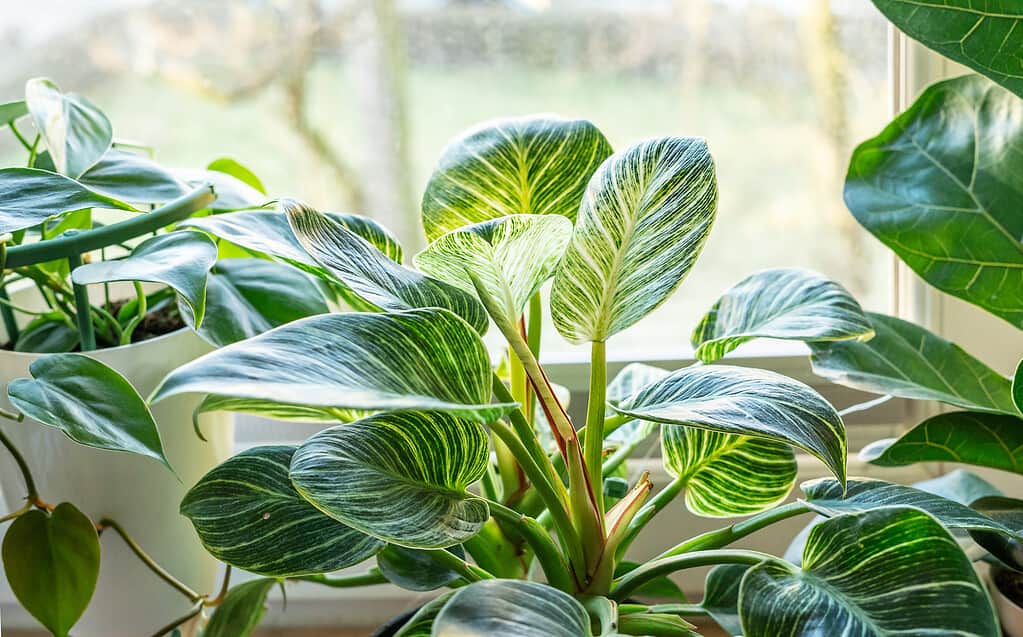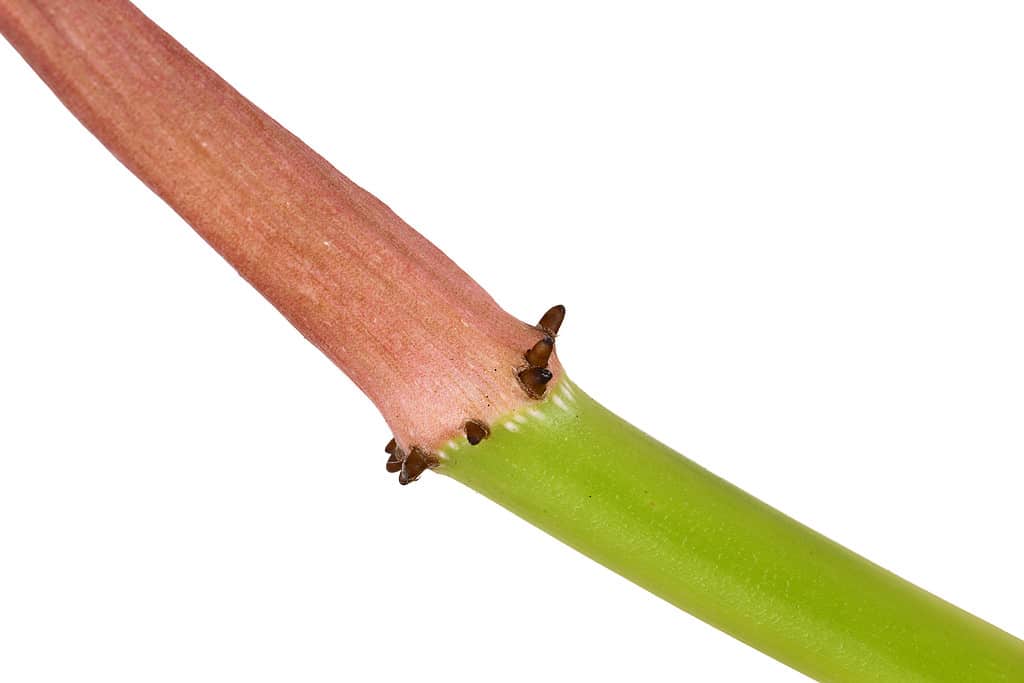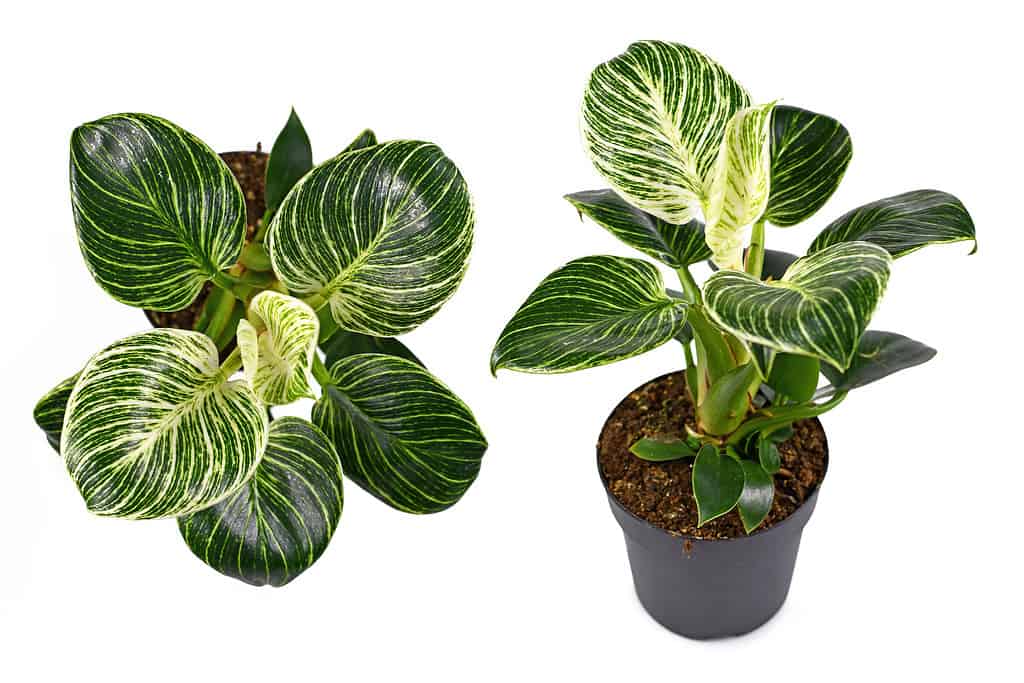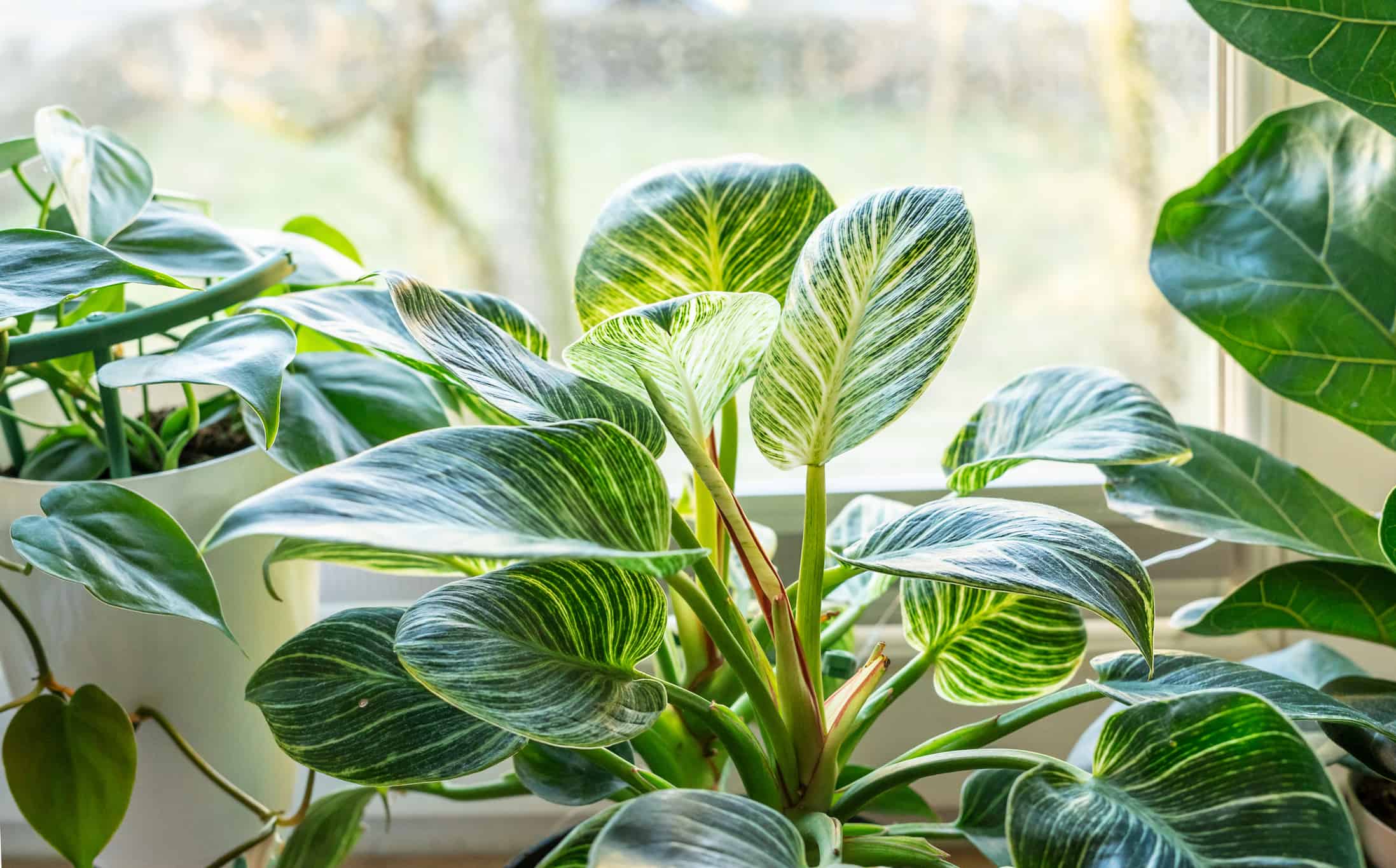Welcome to our comprehensive Philodendron Birkin Care Guide! If you’re a plant enthusiast or new to the world of indoor gardening, this article is your go-to resource for maintaining a healthy and thriving Philodendron Birkin. Along with expert tips, we’ll provide you with the essential knowledge to ensure your plant’s well-being. Let’s dive in!
What is a Philodendron Birkin?

The lovely striped leaves of philodendron Birkin are a joy to grow.
©Darina Saukh/Shutterstock.com
Philodendron Birkin is a beautiful, slow-growing houseplant native to Central and South America. It has lush, glossy deep green leaves with distinctive white stripes, making it a very attractive addition to any home. The leaves are oval-shaped, with a pointed end, and can grow up to 10 inches in length. The stems are slender with a reddish hue.
Overall, the Philodendron Birkin is a beautiful, low-maintenance houseplant that will add a unique, striking look to your home. With its lush, glossy green leaves and attractive white stripes, the Philodendron Birkin is a great addition to any home.
The Best Potting Soil for the Philodendron Birkin
When it comes to potting soil for the Philodendron Birkin, it is important to choose the right kind of soil mix to ensure the health of the plant. It is best to use a soil mix that is well-draining, contains organic matter, and is slightly acidic. Aroid plant mixes are ideal for the philodendron family of plants.
When purchasing potting soil, look for one that is labeled as “soil-less” or “sterile” potting mix, as these mixes will help to prevent the spread of disease and pests. If you can’t find a soil mix specifically designed for the Philodendron Birkin, then a good quality all-purpose potting soil will work as well.
You can also make your own potting soil mix for the Philodendron Birkin. To do this, combine equal parts of peat moss, perlite, and compost. This mix should provide good drainage and be slightly acidic. Additionally, add a slow-release fertilizer to help the plant get the nutrients it needs.
Watering a Philodendron Birkin

Philodendron Birki is still susceptible to root rot, so careful with the over-watering.
©Nataliia Tymofieieva/ via Getty Images
Watering a Philodendron Birkin is easy. Use room temperature water and water thoroughly once per week. Make sure to check the soil beforehand to ensure it’s not too wet. If the top two inches of the soil are dry, water until the soil is saturated and excess water begins to drain from the bottom of the pot. Allow the pot to drain completely and discard any excess water. Avoid overwatering, as this can cause root rot. Symptoms of root rot are soggy stems, yellowing leaves, and lack of growth.
Common Pests and Diseases
Philodendron Birkin plants are often subject to various pests and diseases. To identify and treat these, it is important to be aware of the common pests and diseases that can affect them. Common pests include mealybugs, aphids, spider mites, and scale insects. Common diseases include bacterial leaf spot, root rot, and powdery mildew.
- Mealybugs are small, white, cottony-looking insects that can be found on the stems and undersides of leaves. To treat them, remove the pests with a cotton swab dipped in rubbing alcohol, then spray the plant with insecticidal soap.
- Aphids are small, green, pear-shaped insects that feed on the sap of the Philodendron Birkin. To treat them, use a strong stream of water to knock them off the plant, then spray the plant with insecticidal soap.
- Spider mites are small, red insects that spin webs on the undersides of leaves. To treat them, spray the plant with insecticidal soap.
- Scale insects are small, white, scale-like insects that feed on the sap of the Philodendron Birkin. To treat them, spray the plant with horticultural oil.
- Bacterial leaf spot is a fungal disease that causes spots to form on the leaves of the Philodendron Birkin. To treat it, apply a fungicide to the affected areas.
- Root rot is a fungal disease that causes the roots of the Philodendron Birkin to become soft and mushy. To treat it, repot the plant in new, well-draining soil and apply a fungicide to the affected areas.
- Powdery mildew is a fungal disease that causes a white, powdery substance to form on the leaves of the Philodendron Birkin. To treat it, apply a fungicide.
Providing Adequate Humidity
Achieving the right humidity levels for a Philodendron Birkin is essential for its health and well-being. This tropical plant requires high levels of humidity, with the ideal being between 40-60%. Providing this humidity is relatively straightforward and can be accomplished by misting the leaves regularly or placing a humidifier close to the plant. Additionally, grouping plants together can help increase humidity, as can placing the pot on a tray filled with gravel and water. They make excellent bathroom plants and don’t mind sharing a shower windowsill with your razors and soap.
Temperature
The ideal temperature for a Philodendron Birkin is warm and humid. In their native homes, temperatures typically range from 75-85°F (24-29°C) during the day and 65-75°F (18-24°C) at night, with high humidity. For optimal growth, keep the air in your home between 65-85°F.
How to Prune and Propagate a Philodendron

The node of a philodendron plant looks like this. Plant this part under the soil or submerge it in water, and roots will grow.
©Firn/ via Getty Images
Pruning and propagating a Philodendron Birkin is a great way to ensure its long-term health and growth. You also get free plants out of the deal! Here are some tips on how to get started:
- First, identify the stem of the plant that you want to prune.
- Cut the stem at an angle, just above a node, using a sharp pair of scissors or a knife.
- Once you’ve pruned the stem, you can place it in water or directly into moist soil.
- To propagate, strip the leaves from the lower part of the stem and then place the cutting in water. Be sure that the node is below the water (or soil) line.
- When the roots have grown a few inches, you can transplant them into pots filled with potting mix.
- Once your Philodendron Birkin is planted, make sure to keep the soil moist but not soggy and provide plenty of indirect sunlight and water regularly.
Following these steps will help you prune and propagate your Philodendron Birkin successfully. With a bit of patience and care, you’ll have a whole houseful of free plants to give away.
Repotting a Philodendron Birkin

Be sure that there are only two inches of bare soil around the plant to avoid root rot and fungus gnats.
©Firn/ via Getty Images
When it comes to repotting your Philodendron Birkin, timing is key. The best time to repot is during the early spring, while the plant is still in its dormant period. To prepare for repotting, you’ll need to gather a larger pot, some soil, and a pair of gardening gloves. Begin by carefully removing the plant from its current pot and shaking off the excess soil. Place the plant in its new pot, filling it with the soil and patting it down lightly. Water the plant to ensure that the soil is packed in securely.
Repotting every few years is beneficial as it gives you a chance to refresh the potting mix. If you see the roots growing out of the drainage holes, it is an indication that it needs to be repotted. However, be careful not to go too big with the new pot, as this can cause extra moisture, which can lead to root rot. Generally, a pot that is a couple of inches bigger is enough.
Fertilizing
Fertilizing a Philodendron Birkin is essential for optimal growth. To ensure your Birkin gets the nourishment it needs, fertilize it every four weeks during the growing season with a balanced fertilizer that contains nitrogen, phosphorus, and potassium. Signs of too much plant food include yellowing of the leaves and wilting of the plant. If your Birkin is showing these signs, decrease the amount of fertilizer you are using or increase the frequency at which you water it. Be sure to follow the instructions on the fertilizer label to prevent over-fertilizing your plant.
Philodendron Birkin is Toxic to Children and Pets
Philodendron Birkin is toxic to both children and pets. It is important to keep young children and pets away from this plant, as it can pose a serious health risk. Ingestion can cause burning and irritation of the mouth and throat, difficulty breathing, stomach pain, and vomiting. In extreme cases, it may also lead to other complications. The sap of the plant can also cause skin irritation and rashes. Therefore, it is best to handle this plant with care and keep it out of reach of children and pets.
10 Tips for Growing a Philodendron Birkin
- Place the Philodendron in an area with bright, indirect sunlight.
- Water when the top two inches of soil have dried out.
- Use a well-draining soil mix. Aroid plant mixes are ideal.
- Fertilize during the growing season with a balanced liquid fertilizer.
- Prune away any dead or damaged leaves.
- When repotting, choose a container that is slightly larger than the current one.
- Mist the leaves regularly to increase humidity.
- Keep an eye out for common pests, such as mealybugs, spider mites, and aphids.
- Do not be tempted to overwater. Root rot is the number one killer of houseplants!
- Don’t forget to propagate all of the cuttings and get loads of free plants.
Thank you for reading! Have some feedback for us? Contact the AZ Animals editorial team.








